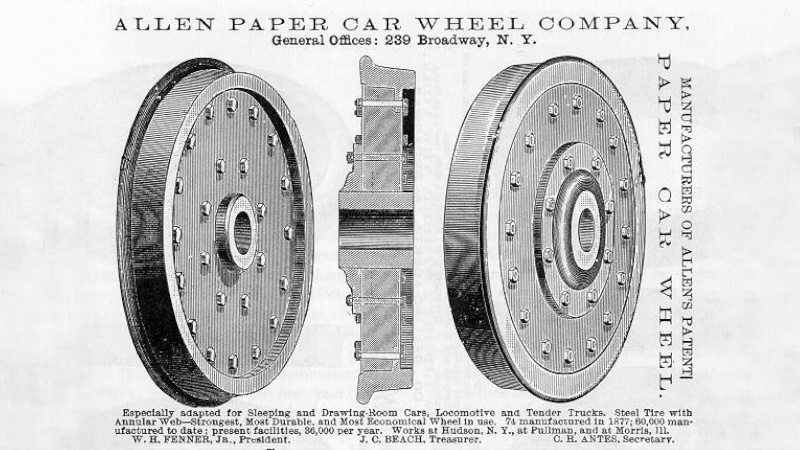Early on, railways primarily used wheels made of wood or iron. The former were cheap and relatively easy to manufacture, while the latter had far superior wear qualities. It may surprise you to learn, however, that some railways once used wheels made out of paper, as [Train of Thought] explains.
The wheels were pioneered by a man known as Richard N. Allen, in the 19th century. The wheels were constructed by layering up hundreds of sheets of paper with glue, compacting them with a press, and allowing them to cure for a few weeks. The solid paper disks were then machined to size, and were drilled to accept bolts that attached metal plates for protection. The wheels were given a cast-iron hub and a steel rim for wear reasons.
The benefit of the wheels was that their composite paper construction helped damp vibrations and noise from the wheels and rails. The North American Pullman railway ended up using the wheels for sleeper and dining carriages for the more luxurious ride they provided.
The paper wheels were short lived, however. While the wheels were up to the task when new, they would fail much sooner than solid metal wheels. A series of derailments led to the wheels being declared unsafe for use in the US by 1915.
The wheels serve as a good example of wheels and tires acting as a tuned part of a whole suspension system. Experimental wheel designs come and go, but there are reasons why we landed on certain designs for certain applications, after all. Video after the break.

















History repeats itself? Didn’t a high speed train derail due to composite wheel failure, taking out a road overpass and an oncoming train, northern Europe within last decade?
There would be far less fatal accidents if everyone had to drive a BMP-1 or MT-LB instead of those tin cans made of steel so thin it can’t be TIG welded without using some very advanced arc control algorithms.
It’s a contrast to older cars. My father had 1988 FSO Polonez and it was made of 2 mm thick steel. When rust developed my old man was able to simply cut damaged parts with angle grinder and weld new plates using basic trafo stick welder.
Does the BMP-1 have a well designed crumple zone? I had not heard that.
Just sit farther back, and fill the space In front of you with packing peanuts.
It uses the vehicle it runs into as a crumple zone.
BMP-1 has a boat-shaped hull,it will rise up if crushed severely
Fatal is binary, so less fatal is not correct. Perhaps FEWER fatal accidents is what you mean?
The https://en.wikipedia.org/wiki/Eschede_train_disaster in 98 matches your description. Though there have been a few incidents over the year with multiple ply wheels failing.
Thanks for the link!
Interesting…
I wonder how paper wheels would work on cars?
I don’t know, maybe ask a Trabant owner?
B^)
Excuse me, I asked for paper, not plastic.
Somewhat relevant: https://www.youtube.com/watch?v=4qCviSCHni8
Oh, that was great. Sign me up!
Wow, that was quite impressive, this guy deserves a research grant from the Russian government.
Did it?
Was banned after several derailments? Never would’ve guessed!
Why not make them from solid hardwood with a steel hub and tightening bands for strength. Something like the solid wheel picture here, but with a steel band and hub: https://en.wikipedia.org/wiki/Wheel
So in 1915 a series of derailments was frowned upon then eh. How things changed.
Basically he invented MDF